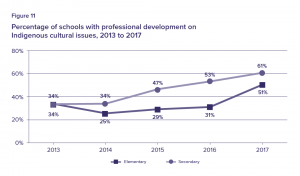Indigenous education 2017
The results from this year’s survey show a substantial improvement in Indigenous educational opportunities. According to the report, the improvement reflects the province’s commitment to implementing the “Calls to Action” from Canada’s Truth and Reconciliation Commission. The province has also implemented funding and policy aimed at increasing all students and educators’ knowledge about the “rich cultures and histories” of Indigenous peoples and improving educational outcomes for Indigenous students.

In 2017:
- 66% of elementary and 80% of secondary schools offer Indigenous education opportunities, including things like language programs, guest speakers, and professional development for teachers. This is an increase from 49% and 61% respectively, since 2013.
- 51% of elementary and 61% of secondary schools offer professional development in Indigenous education – an increase from 34% in 2013.
In the First Nation, Métis, and Inuit Education Policy Framework Implementation Plan, the Ministry of Education set 2016 as the target date for closing the gaps in education outcomes (i.e. literacy, numeracy, retention, graduation) between Indigenous and non-Indigenous students. The Implementation Plan also stated that the province would collaborate with First Nation, Métis, and Inuit partners, and key education stakeholders to explore and identify additional indicators of student achievement, well-being and self-esteem.
